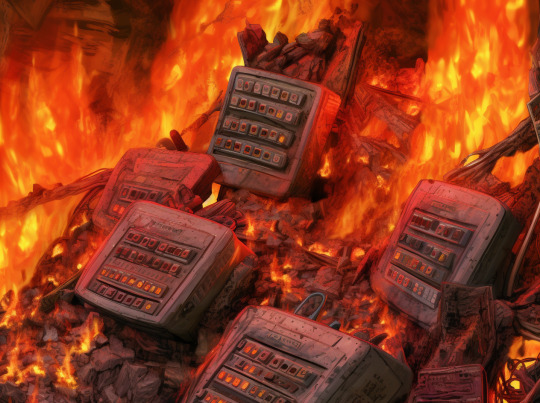#downcycle
Text
Downcycling
Downcycling, in contrast, is the devaluation of a piece. Though less showy than upcycling, downcycling will extend the life of your garment, in turn reducing the amount of waste in the landfill. Examples of downcycling include using a hole-ridden sock as a rag, or stuffing a pillow or dog bed with old t-shirts. While the most common form of recycling sees products broken down and formed into the same or similar products, the practices of “upcycling” and “downcycling” have become creative and sustainable ways to employ valuable materials and preserve natural resources. While upcycling and downcycling are both examples of recycling, not all recycling is considered equal. When we convert discarded materials into something of equal or greater value, it is "Upcycled". When a material or product is “Downcycled", it is transformed into something of lesser value.
0 notes
Text
i need ... motivations lol
#i have a load of stuff i wanna do but i think ive been highkey switched on for a while now and im on a downcycle#saaaad :(#i gotta get charity stream organised so i can chill on it though ... same with some college work ...... bbrrrrrrr#rory's ramblings
5 notes
·
View notes
Text
i feel like one of the best feelings when you’re a creative of any sort is seeing someone else’s thing and having a moment of ‘wait! i can do that too!’
#stumbled across a tutorial for plarn (plastic ‘yarn’) where they snipped up plastic bags and turned them into something to crochet with#and i went >:O i can do that too! i have so many extra bags from grocery shopping!#seriously i have so many. i can’t use them faster than i can eat#so like! fuck yeah! i can downcycle these fuckers into something useful!
6 notes
·
View notes
Text
It’s an open secret in fashion. Unsold inventory goes to the incinerator; excess handbags are slashed so they can’t be resold; perfectly usable products are sent to the landfill to avoid discounts and flash sales. The European Union wants to put an end to these unsustainable practices. On Monday, [December 4, 2023], it banned the destruction of unsold textiles and footwear.
“It is time to end the model of ‘take, make, dispose’ that is so harmful to our planet, our health and our economy,” MEP Alessandra Moretti said in a statement. “Banning the destruction of unsold textiles and footwear will contribute to a shift in the way fast fashion manufacturers produce their goods.”
This comes as part of a broader push to tighten sustainable fashion legislation, with new policies around ecodesign, greenwashing and textile waste phasing in over the next few years. The ban on destroying unsold goods will be among the longer lead times: large businesses have two years to comply, and SMEs have been granted up to six years. It’s not yet clear on whether the ban applies to companies headquartered in the EU, or any that operate there, as well as how this ban might impact regions outside of Europe.
For many, this is a welcome decision that indirectly tackles the controversial topics of overproduction and degrowth. Policymakers may not be directly telling brands to produce less, or placing limits on how many units they can make each year, but they are penalising those overproducing, which is a step in the right direction, says Eco-Age sustainability consultant Philippa Grogan. “This has been a dirty secret of the fashion industry for so long. The ban won’t end overproduction on its own, but hopefully it will compel brands to be better organised, more responsible and less greedy.”
Clarifications to come
There are some kinks to iron out, says Scott Lipinski, CEO of Fashion Council Germany and the European Fashion Alliance (EFA). The EFA is calling on the EU to clarify what it means by both “unsold goods” and “destruction”. Unsold goods, to the EFA, mean they are fit for consumption or sale (excluding counterfeits, samples or prototypes)...
The question of what happens to these unsold goods if they are not destroyed is yet to be answered. “Will they be shipped around the world? Will they be reused as deadstock or shredded and downcycled? Will outlet stores have an abundance of stock to sell?” asks Grogan.
Large companies will also have to disclose how many unsold consumer products they discard each year and why, a rule the EU is hoping will curb overproduction and destruction...
Could this shift supply chains?
For Dio Kurazawa, founder of sustainable fashion consultancy The Bear Scouts, this is an opportunity for brands to increase supply chain agility and wean themselves off the wholesale model so many rely on. “This is the time to get behind innovations like pre-order and on-demand manufacturing,” he says. “It’s a chance for brands to play with AI to understand the future of forecasting. Technology can help brands be more intentional with what they make, so they have less unsold goods in the first place.”
Grogan is equally optimistic about what this could mean for sustainable fashion in general. “It’s great to see that this is more ambitious than the EU’s original proposal and that it specifically calls out textiles. It demonstrates a willingness from policymakers to create a more robust system,” she says. “Banning the destruction of unsold goods might make brands rethink their production models and possibly better forecast their collections.”
One of the outstanding questions is over enforcement. Time and again, brands have used the lack of supply chain transparency in fashion as an excuse for bad behaviour. Part of the challenge with the EU’s new ban will be proving that brands are destroying unsold goods, not to mention how they’re doing it and to what extent, says Kurazawa. “Someone obviously knows what is happening and where, but will the EU?”"
-via British Vogue, December 7, 2023
#fashion#slow fashion#style#european union#eu#eu news#eu politics#sustainability#upcycle#reuse#reduce reuse recycle#ecofriendly#fashion brands#fashion trends#waste#sustainable fashion#sustainable living#eco friendly#good news#hope
10K notes
·
View notes
Photo

👀🌸💕💯 Ari wears Bubble Rush Top and Patchwork Blanket Sweatpants. The latter are still available 💯💯 Clothing, Styling, Creative Direction (or lack thereof) @jontykmellmann Photography @gregoremmanuel_ Models @ufokink @maggot.brains 🙏🙏🙏 #alternativefashion #fantastictoiles #downcycling #upyours #gothiclolita #swaggysweats #bubblytop #pastelgoth #harajukufashion #londonfashion #swag #drip #jontykristianmellmann (at Fountayne Road) https://www.instagram.com/p/Ciw5g9TtoHQ/?igshid=NGJjMDIxMWI=
#alternativefashion#fantastictoiles#downcycling#upyours#gothiclolita#swaggysweats#bubblytop#pastelgoth#harajukufashion#londonfashion#swag#drip#jontykristianmellmann
0 notes
Text

Silicone Recycling
While consumer silicone products are often selected to replace single-use plastics, reducing the amount of waste generated overall, they too eventually must be disposed of - so what happens to the waste? Although silicone is a polymer, it has a silicon, oxygen based backbone, not carbon based like most polymers and plastics known. As such, silicone will often find its way into landfills when recycled by consumers, as it cannot be recycled with the other polymers in the stream. Silicone is not biodegradable, and takes a considerable length of time to break down.
Silicone can be recycled at designated recycling centers, though typically through mechanical means, resulting in a 'downcycled' product. Apart from consumer recycling, overall recycling rates of silicone is expected to steadily increase over the coming decade.
Sources/Further Reading: (Image source - Gosili) (2023 article) (2022 book chapter) (Business Research Insights) (Newtop blog) (1997 book chapter)
#Materials Science#Science#Silicone#Polydimethylsiloxane#Polymers#Recycling#Waste#WasteWednesday#2024Daily
26 notes
·
View notes
Text
#tiktok#bobs burgers#bob's burgers#linda belcher#louise belcher#tina belcher#gene belcher#gene bobs burgers#louise bobs burgers#tina bobs burgers#art
12 notes
·
View notes
Note
You know how the business works so I gotta ask you about my theory: is it possible that Jensen is not getting work because he's too expensive for certain type of supporting roles so the producers don't even consider him? If you look at someone like Sebastian Roché, he's constantly working. But he's less "high profile" than Jensen. So Jensen finds himself in a bit of a tough situation. Leading or other main roles don't work out, and he's too pricey for smaller stuff that he would be really good for?
While Jensen's business model makes my eye twitch, I highly doubt he would demand higher salary for supporting or recurring roles in this current climate. Now, his team may be a different story as I've speculated here before that they may have soft-sabotaged Jensen's career because they only wanted him in lead roles. Hopefully that's no longer the case once Jensen went out and got his own non-lead roles in The Boys and Big Sky.
Actors in existing roles will not see normal pay increases as series are extended, more roles being cast and paid as recurring instead of regular, and with fewer pilots there are less chance taken on less known actors. Studios and networks believe there are only a small number of actors who are “known quantity”, which is a combination of work ethic, recognition, and upward-spiraling visibility. Emphasis on the work ethic.
There were an over saturation of actors and crew brought on by Netflix's saturating the market with content in order to crowd out their rivals. Crews in LA raised their rates so aggressively during and post pandemic to cash in on the content creation rush, but that was not sustainable. Which is why people who have done this for a long time have seen several down cycles and then see things come back but feel it is different this time due to the tech industry.
The tech bubble started in 2010s and grew at such abnormal rate for 10 years that it stands to reason that the downcycle would be abnormally substantial as well, maybe there lies the reason why it feels different this time.
13 notes
·
View notes
Text
13 notes
·
View notes
Text
ive suggested prior that maybe the shadow mages running the maw got their operation model from soul tech. but what if soul tech is actually just downcycled shadow magic? it'd fit thematically, i think; it's a more streamlined alternative of a stolen magic practice that's gone thru enough retooling to allow workers with no second sight to do it themselves. it's up for debate if the scissor man has second sight/is the only person responsible for the production of metrognomes, but if not, then there's no one more precise at separating the human soul from the body than him. except, you know, the lady, whose ancestors' magic was appropriated by a foreign conglomerate (not sure how much it matters though, they're both awful). it might be why they feel kinda similar to me though
i think it'd be funny if the lady knew all along, but never once said anything, yet was secretly manifesting the corporation's demise. in fact the whole reason i made this connection is bc of the metrognome easter egg in roger's room (which he obv can't see), so assuming people's knowledge of metrognomes did die with the city, then roger only knows what he knows thru the lady talking smack LMAO
#little nightmares#city of metronome#theories#fan meta#lady and scissor man enemyship >>>>> all others#kramblings
7 notes
·
View notes
Text




DownCycled
"Damned machine!" is the kind of curse you let slip without thinking twice. Rightly so. Your Blackberry got here on its own, completely without your help.
It knows what it did.
The images above in this post were made using an autogenerated prompt and/or have not been modified/iterated extensively. As such, they do not meet the minimum expression threshold, and are in the public domain.
Prompt: the fire is moving on a background of electrical objects, in the style of surreal cyberpunk iconography, thick impasto texture, giant money sculptures, macro zoom, mommy's on-the-phonecore, contemporary chinese art, photorealistic detail
#unreality#ai artwork#art by OP#midjourney#midjourney v5#generative AI#public domain images#public domain#free art#hell#fire#burning cell phones
11 notes
·
View notes
Text
youtube
Wind turbines are playing a big part in cleaning up our energy system. But even the best solution isn't without its problems: the blades are close to impossible to recycle and largely end up in landfills. There are more and more companies promising to fix that. Can they?
#PlanetA #WindEnergy #Recycling
We're destroying our environment at an alarming rate. But it doesn't need to be this way. Our new channel Planet A explores the shift towards an eco-friendly world — and challenges our ideas about what dealing with climate change means. We look at the big and the small: What we can do and how the system needs to change. Every Friday we'll take a truly global look at how to get us out of this mess.
Credits:
Reporter: Malte Rohwer-Kahlmann
Video Editor: David Jacobi
Supervising Editor: Joanna Gottschalk
Factcheck: Jeannette Cwienk, Alexander Paquet
Thumbnail: Em Chabridon
Read More :
Wind Turbine Blade Waste in 2050 (Liu & Barlow, 2017):
https://core.ac.uk/download/pdf/96705...
Blade Waste in the United States (Cooperman et al., 2021):
https://www.osti.gov/pages/servlets/p...
Vestas's press release:
https://www.vestas.com/en/media/compa...
Siemens Gamesa's press release:
https://www.siemensgamesa.com/en-int/...
Chapters:
00:00 Intro
01:01 Blade waste
02:53 Downcycling
05:10 New blades
06:51 Breakthrough?
08:18 What's at stake
#dw planet A#solarpunk#wind turbines#wind turbine#wind power#clean energy#Green energy#renewable energy#recycling#turbine blades#Youtube
5 notes
·
View notes
Text
Blackstone Raises $30 Billion For "Largest Ever" To Capitalize On Real Estate Crisis
From Zero Hedge:
Ken Caplan, Global Co-Head of Blackstone Real Estate, said, "We believe the current market is tailor-made for Blackstone Real Estate. We have made some of our best investments in periods characterized by the market volatility and dislocation we see today...
“Pullback with all forms of capital will create opportunities,” said Kathleen McCarthy, global co-head of Blackstone Real Estate. “We can use our capital and expertise to capitalize on the moment for our investors.”
In other words, even as existing Blackstone investments are deeply underwater, the PE giant which now has $326 billion of investor capital under management - will seek to purchase distressed CRE assets during the coming downcycle, becoming even more entrenched and an even greater monopoly in the sector.
5 notes
·
View notes
Text
i am at least noticing when my mood is sliding down earlier.
it happens a bit too often for my liking though.
hm. hopefully this downcycle is short.
#i know how to cope but not how to make it stop#i'll tell my psych guy and my therapist though#maybe they have the answers
2 notes
·
View notes
Photo

NEW STUFF ON BIGCARTEL Link in bio Stuff I never posted. Brown Scarf Shirt (available), Independent Tee and Red Kombat Sweatpants. As worn by @e.andrews18 #jontykristianmellmann #redrubberroses #bigcartel #rrr #buyitnow #altfashion #downcycling #countrycrust #horsey #neigh (at Horsing Around The Stables) https://www.instagram.com/p/CgOqyXrNI9H/?igshid=NGJjMDIxMWI=
#jontykristianmellmann#redrubberroses#bigcartel#rrr#buyitnow#altfashion#downcycling#countrycrust#horsey#neigh
0 notes
Text

New method of recycling colored plastics offers possible solution to 'huge environmental challenge'
A new method for recycling colored plastics has been developed by scientists at Cardiff University.
The process, which breaks down colored polymers, the principal component of plastics, into their original components, could lead to a circular plastic recycling economy reducing pollution on land and in our oceans, the researchers claim.
Widely used in drinks bottles, food packaging, clothing and electronics, colored plastics can be melted down and remolded into new products, but additives or colorants cannot be removed in current recycling processes.
To avoid this method of downcycling, where recycled plastic is of lower quality than the original material, the Cardiff team used a chemical process called depolymerization.
Read more.
#Materials Science#Science#Recycling#Polymers#Plastics#Color#Environment#Materials processing#Cardiff University
14 notes
·
View notes